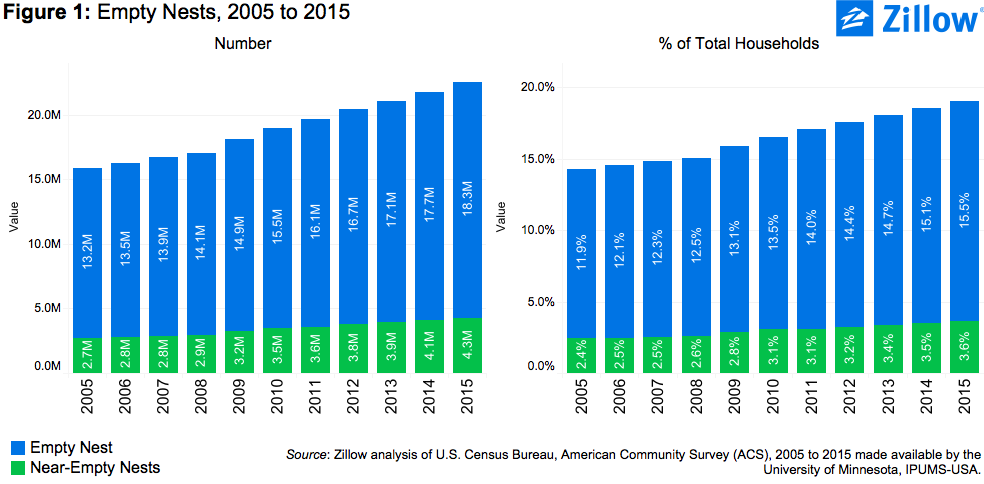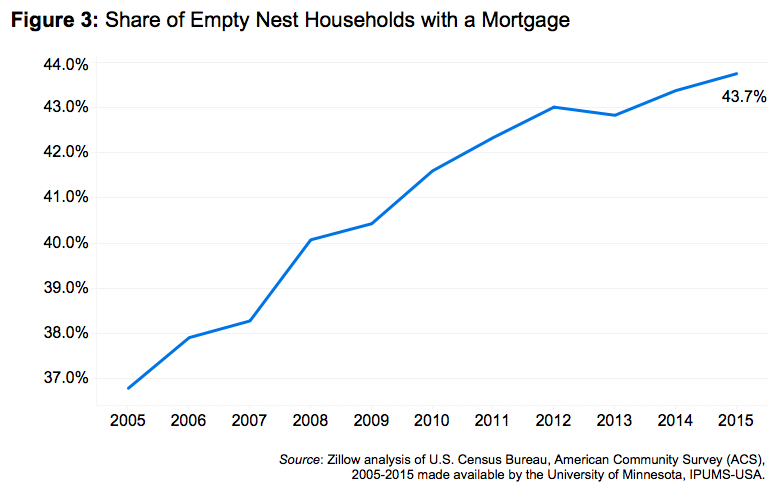Empty Nest Households Are on the Rise
Pricey markets and those with weak labor markets have high concentrations of empty nests. Low densities of empty nests are found in booming cities with strong job markets, new family-oriented areas, and retirement communities.
- More than a fifth of households in the Great Lakes region is an empty nest, while Sunbelt markets have the lowest density.
- Pricey markets and places with weak labor markets have high concentrations of empty nests.
- Low densities of empty nests are found in booming cities with strong job markets, retirement communities and new family-oriented areas.
Maybe it’s something in the water. The Great Lakes region has spent the past year collecting victories in baseball, basketball and hockey — and now three of its cities can add empty nest credentials to that quiver. Buffalo, NY; Cleveland and Detroit rank among the top 10 markets with the highest concentrations of older homeowners in large, single-family homes with no kids.
The top honor goes to Pittsburgh, which is a little downstream and squarely in the Rust Belt. More than a fifth of Pittsburgh’s households are empty nests.
Empty nests, in general, are gaining ground: As Baby Boomers age, the number and share of empty nests steadily grows – rising from 11.9 percent (13.2 million) of all households nationwide in 2005 to 15.5 percent (18.3 million households) in 2015.[1]
These markets had the most empty nests in 2015 (% of households that were empty nests):
- Pittsburgh (20.2%)
- Buffalo, NY (20.1%)
- Cleveland (19.4%)
- Richmond, Va. (18.6%)
- Birmingham, Ala. (18.3%)
- Philadelphia (18.2%)
- Detroit (17.9%)
- Virginia Beach, Va. (17.4%)
- Louisville, Ky. (17.2%)
- Baltimore (17.0%)
An additional 3.6 percent of households (4.3 million) are “near-empty” nests, meaning they would be empty nests if an adult child currently living at home were to break out on their own. That’s up from 2.4 percent (2.7 million households) in 2005.[2]

Communities in the Great Lakes region have the highest densities of empty nests – led by Youngstown, Ohio,, Scranton, Pa., Syracuse, N.Y.,, Pittsburgh and Buffalo, N.Y., where more than one-in-five households is an empty nest. At the other extreme, Sunbelt markets such as McAllen, Texas; Las Vegas; Austin, Texas; Miami-Fort Lauderdale; and Provo, Utah, have the lowest densities of empty nests.
The places with the lowest densities of empty nests include booming cities with strong job markets (e.g., Austin, Texas; Phoenix, San Francisco and Dallas), new family-oriented communities (e.g., McAllen, Texas; Provo, Utah; and Riverside, Calif.), and retirement communities (e.g., Fort Myers, Tampa, and Orlando, all in Florida).

Communities that rank high for “near-empty” nests tend to be less affordable or have weak labor markets, places where young adults are likely to live with their parents for longer. For example, pricey coastal markets Honolulu and Ventura, Calif., rank highest nationally for “near-empty” nests. However, places with weaker labor markets like Philadelphia, New Haven, Conn., Youngstown, Ohio, and Detroit also rank high. Affordable, family-oriented communities – including Las Vegas, Austin, Texas, Phoenix, Indianapolis, Albuquerque, N.M., and Omaha, Neb. – rank low for both empty nests and “near-empty” nests.
Over the past decade, the share of empty nests that carry a mortgage has also climbed steadily upward. In 2005, 36.8 percent of empty nesters – or 4.9 million households – had a mortgage still outstanding; by 2015, the share had increased to 43.7 percent, or 8 million households.

Markets with less affordable housing generally have higher shares of empty nesters with outstanding mortgages. Among the markets examined, Ventura, Calif.; Washington, D.C.; Riverside, Calif.; and Sacramento, Calif., have the highest shares of empty nesters with a mortgage.
Related:
[1] “Empty nests” are defined as households where heads of household are age 55+, own their homes, have lived in their current home for 10 or more years and have no children of any age living at home.
[2] “Near empty nests” are defined the same as “empty nests,” except with at least one adult child living at home.



